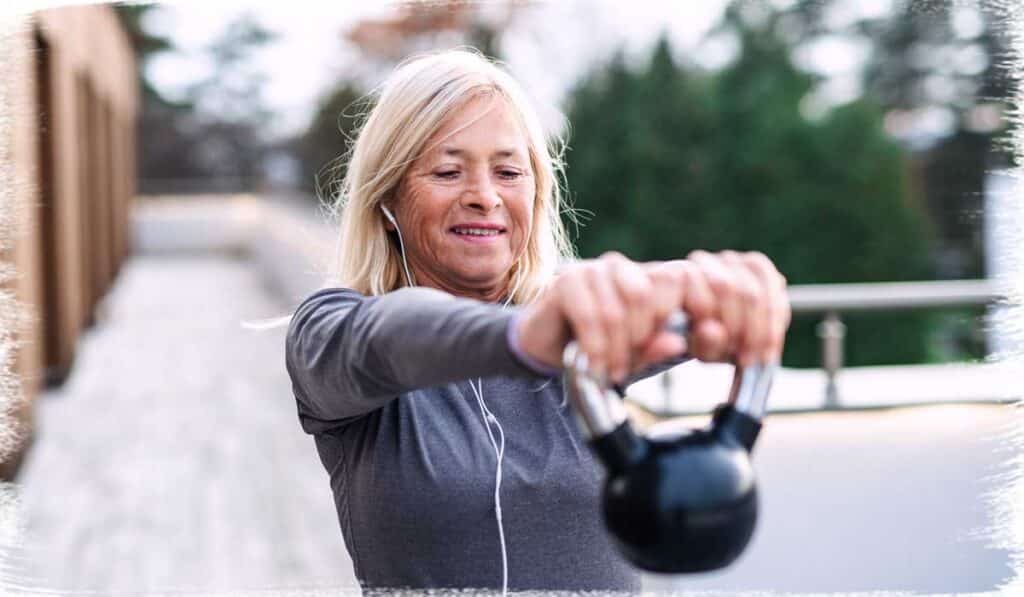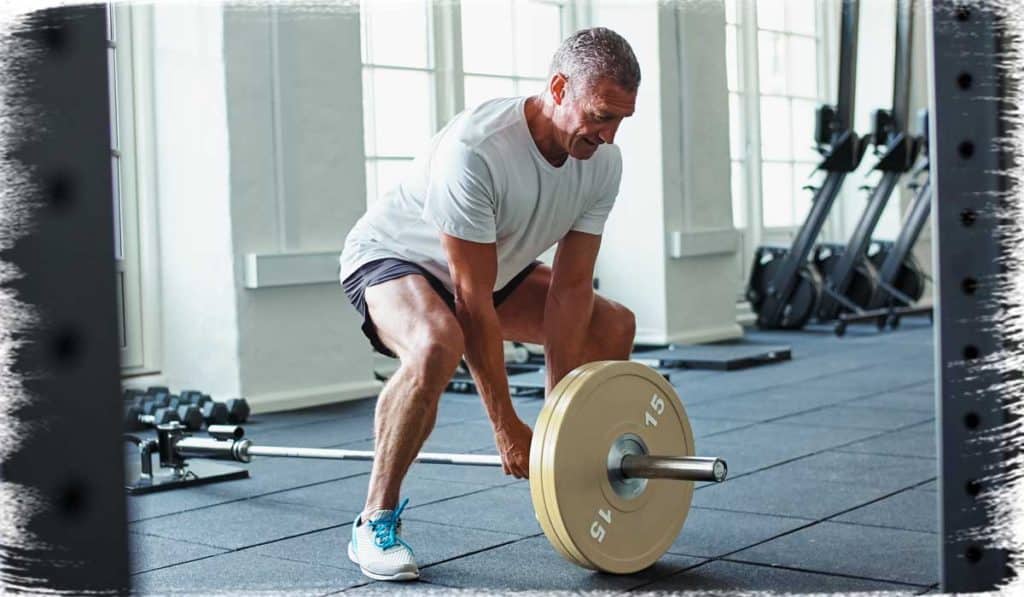As a physical therapist and certified strength & conditioning specialist, blood flow restriction is an intervention that I believe holds great benefit and promise for seniors wishing to stay strong, active, and avoid the troubling effects of sarcopenia (decreased muscle health). When used properly and on the appropriate individuals, it can be a real game-changer for those who use it. Many of my patients and clients can attest to this.
But if you’re a senior who is wanting to start doing blood flow restriction training, how do you know which exercises are best for you to use? Well, thankfully we can take a look into the results of various academic studies and dissect the scientific findings.
The best blood flow restriction exercises for seniors involve the 30/15/15/15 protocol and walking regimens for approximately 20 minutes in length. Both of these protocols have been shown in academic literature to effectively improve muscle size, strength, and endurance in seniors.
If you’re interested in learning the specifics of these protocols, how to get the most out of them, and/or what the academic literature has found for validating these training methods, then be sure to keep on reading, as they will be discussed in detail below.

To help you save time, you can use the article headlines below to instantly navigate to that section of the article. These are quick links, so simply click (or tap) on the following article headlines to jump to that particular section.
ARTICLE OVERVIEW:
- Walking protocols
- How frequently to perform a walking protocol
- The 30/15/15/15 protocol
- How frequently to perform the 30/15/15/15 protocol
- How to select the right type of resistance training movements
- Final thoughts
Related article: BFR Training for the Elderly: Why Smart Seniors are Using it
Disclaimer: While I am a physical therapist, I am not YOUR physical therapist. As a result, I cannot tell you whether or not any treatments mentioned on this website or in this article may or may not be appropriate for you, including blood flow restriction training. By following any information within this post, you are doing so at your own risk. You are advised to seek appropriate medical advice for any pain you may be experiencing.
If you’re looking for a professional, high-quality blood flow restriction training system that has been designed by a team of medical professionals, my recommendation is the Bstrong System (link goes to their website). This is the system I use for myself and my patients. You can use the code “JIMWITTSTROM” to receive 10% off of any purchase through their store. Please note: this is an affiliate link that provides me with a commission at no extra cost to you. I use these commissions to offset the cost of running this website.
Walking protocols

Every senior using BFR training (or wanting to use it) needs to know about walking protocols and the positive effects that they can bring. While most people tend to think of performing traditional resistance training exercises (squats, arm curls, etc.) when using BFR interventions (which are also great), walking is oftentimes less well known by the average user.
This really is a shame since science has not only found some great benefits with BFR walking but also since walking doesn’t tax arthritic or unhealthy joints the ways that other traditional resistance training exercises or activities can.
Aside from walking being a functional activity that’s required for activities of daily living (ADL’s), it’s extremely beneficial in that regimented walking can help maintain healthy ranges of motion for the joints of the body while also providing positive changes in cardiovascular health.
While traditional walking won’t do a whole lot for improving muscle strength (but is still a heck of a lot better than nothing), studies have shown that walking with blood flow restriction cuffs placed around the upper thighs have been able to elicit statistically significant improvements for both muscle strength and size when compared to study participants who engaged in the same walking regimens without incorporating blood flow restriction training.
The benefits of these outcomes are numerous; with blood flow restriction training, seniors now have a way to improve their cardiovascular health, spare their joints of painful exercise demands AND improve muscle size and strength all at the same time!
Combine this with the fact that walking is a simple movement that does not require specialized training while also being a readily accessible exercise mode that does not require expensive or specialized equipment and you have the perfect way to improve muscle strength in seniors.
In the Covid-19 era, seniors don’t have to worry about stepping foot into crowded gyms in order to strengthen their bodies. They can get muscle strengthening benefits to their legs by walking outdoors or on a treadmill at home. For those who never enjoyed going to gyms to begin with, they now have the ability to strengthen muscles without needing hardly anything for expensive or bulky equipment.
If you’re looking for more of the specifics with walking protocols and it’s positive effects on seniors, you can check out the following scientific articles:
- Legs and trunk muscle hypertrophy following walk training with restricted leg muscle blood flow
- Increases in Thigh Muscle Volume and Strength by Walk Training with Leg Blood Flow Reduction in Older Participants
- Effects of Blood Flow Restriction Training on Muscular Strength and Hypertrophy in Older Individuals: A Systematic Review and Meta-Analysis
How frequently to perform a walking protocol

In literature, walking protocols tend to be conducted with a frequency of one time per day for 4-6 days per week. If that sounds like more walking than you’d like to do, this great study by Ozaki et al. (link takes you to article) demonstrated significant changes in muscle size and strength in seniors with twenty-minute walks four days per week over the course of ten weeks. That’s immensely impressive for simply walking on a regular basis.
So, while studies have examined the effects of walking protocols with a frequency above four times per week, it seems rather reasonable that seniors could expect to see muscle size and strength changes in their lower body at a frequency of only four times per week.
It’s also possible that one could potentially get results with only walking three times per week, however, it’s less likely and certainly to be expected that the results wouldn’t be as great as when compared to walking four times per week (or more), so I would suggest performing BFR walking for twenty minutes at least four times per week.
The 30/15/15/15 protocol (used for most exercises in the literature)
When it comes to resistance training protocols for eliciting the muscle strengthening effects of blood flow resistance training, the most widely utilized protocol in scientific literature is what’s known as the 30/15/15/15 protocol. This protocol has been used in numerous studies and has typically shown to yield statistically favorable results for improving muscle size and strength when compared to study subjects who utilized the same protocol without wearing restriction cuffs.
Related article: Blood Flow Restriction: Evidence and Uses in Clinical Rehabilitation
What are the specifics of this protocol?
The numbers in the 30/15/15/15 protocol stand for the number of repetitions that are performed for a given exercise. Since there are four sets of numbers, this means that the exercise is done for four total sets. The repetitions for each set are performed in a continuous manner without taking rest breaks. Once the set has been completed, a thirty-second rest break is given before the next set begins. This process is completed until all four sets have been completed for the exercise.
With this protocol, subjects in various studies tend to use resistance of 20-30% of their overall maximal abilities when not restricted from wearing cuffs. This means that if a subject had a maximum squat of 100 pounds when not wearing cuffs, they would use 20-30 pounds when squatting with the cuffs on for the 30/15/15/15 protocol.
How many exercises per session should you use with this protocol?
In terms of how many exercises should be performed per workout/exercise session with this protocol, it can vary and really comes down to the comfort and overall fitness of the individual. If you’re brand new to exercise or blood flow restriction training, it’s best to start with just one exercise per session and see how your muscles tolerate it over the next one or two days.
As your body adapts over time to this training style and specific protocol, you can begin to incorporate more exercises each session with the restriction cuffs in place while using this repetition scheme/protocol.
How frequently to perform the 30/15/15/15 protocol
In order to get the most favorable training responses when using blood flow restriction training, the muscles must be stimulated at an appropriate frequency in order for adaptations to occur. This frequency is typically measured on a weekly basis.
While the frequency of resistance training varies across the scientific literature when determining the ideal amount of weekly training for seniors, most studies suggest that a frequency of 3 days per week for a muscle group yields favorable results. These studies also suggest that noticeable increases in muscle strength and size become noticeable once this frequency has been maintained beyond six weeks in length. To read this in a bit more detail, here is a great meta-analysis covering these topics:
There are a lot of factors in play here, so it’s not a hard and fast rule. But what’s great is that since the exercise intensity is much lower with BFR training than when compared to traditional strength and resistance training, seniors are typically able to increase their training frequency throughout the week( if so desired) since there is less taxation on the body with each session, requiring less downtime for recovery before the body is ready for the next session.
How to select the right type of resistance training movements

When it comes to selecting the most ideal exercises or resistance training-based movements to perform, there can be a world of considerations to take into account, however, there are usually some pretty universal principles to keep in mind, assuming the individual is relatively healthy and looking to maximize muscle strength and function.
For a much more extensive article covering how to select the most ideal resistance training exercises when using blood flow restriction training, be sure to check out my other blood flow restriction training articles.
If you’re simply looking for a quick rundown on how to make sure you’re selecting appropriate exercises, what follows below are some basic principles that will help ensure you select ideal exercises and movements when performing your training:
Pick movements that don’t cause any pain
The first principle to adhere to is that any exercises that you select shouldn’t cause any pain. Fatigue and pain are two separate conditions, so keep this in mind. You want to feel like any exercise that you choose is one that your body is tolerating well. Challenging your body so that the muscles become fatigued is the goal, but having to work through pain in order to achieve that goal is not acceptable nor ideal.
If a movement or exercise is painful for the joint(s) or any muscles (or any other area of your body), you are best to either try to modify the movement in a way so that you can continue without the pain, or to simply find another exercise altogether. Trying to find an alternative exercise that is similar to the movement causing you pain is a good approach to take if you just can’t seem to find a pain-eliminating position when trying your originally intended exercise.
Pick exercises that challenge multiple muscles at the same time

If you’re wanting to strengthen as many muscles as possible in a given time (and to really maximize the overall strengthening effects of the blood flow restriction), you’ll want to try and select exercises and movements that challenge multiple groups of muscles all at once.
Keep in mind that there are plenty of benefits to focusing on a single muscle group per exercise, so it’s not to say that doing so should be entirely avoided. Rather, there is a great functional benefit to picking movements and exercises that challenge a bunch of muscles at the same time, especially if wanting to keep exercise sessions short and simple (a few exercises that each challenge multiple muscle groups is a lot quicker than performing a bunch of exercises that only challenge one muscle group at a time).
There’s also the benefit of building up a much larger BFR-induced metabolic environment by performing multi-muscle movements than when compared to single-muscle group exercises, but this is beyond the scope of this article.
If you’re not sure how to tell which exercises work multiple muscle groups at the same time, there’s an easy way to know for certain: multi-muscle group exercises tend to involve moving multiple joints of the body throughout the exercise (they’re sometimes referred to as compound movements).
An example would be squats or lunges – these exercises require you to move your knee joints, your hip joints, and even your ankle joints in order to do them successfully. As a result, muscles around your hips, your thighs, and your calves are all working simultaneously in order to complete the movement.
Final thoughts
If it’s appropriate, incorporating blood flow restriction training into health and fitness exercise regimens for seniors can be an incredibly effective strategy to incorporate. And if doing so, picking the most scientifically proven training protocols tends to be a good plan.
Using walking programs or a resistance training-based approach utilizing the 30/15/15/15 protocol will likely yield great outcomes in muscle size, strength, and endurance all while reducing physical taxation or exercise demand on the body.
By exercising at low intensities while still reaping the rewards of traditional strength training, seniors can have more confidence in maintaining or improving their musculoskeletal strength, helping to ensure that they not only have greater confidence with their daily movement and activities but that they will also likely experience less pain and physical limitation. This equates to a higher quality of life, something that all individuals (including seniors) should always strive for.

Hi! I’m Jim Wittstrom, PT, DPT, CSCS, Pn1.
I am a physical therapist who is passionate about all things pertaining to strength & conditioning, human movement, injury prevention and rehabilitation. I created StrengthResurgence.com in order to help others become stronger and healthier. I also love helping aspiring students and therapists fulfill their dreams of becoming successful in school and within their clinical PT practice. Thanks for checking out my site!

